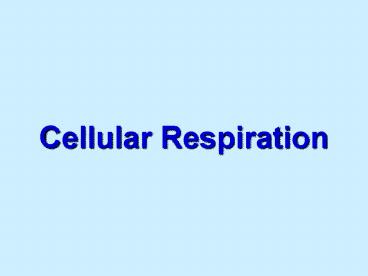Cellular Respiration - PowerPoint PPT Presentation
1 / 26
Title:
Cellular Respiration
Description:
Cellular Respiration – PowerPoint PPT presentation
Number of Views:77
Avg rating:3.0/5.0
Title: Cellular Respiration
1
Cellular Respiration
2
Cellular Respiration
- A catabolic, exergonic, oxygen (O2) requiring
process that uses energy extracted from
macromolecules (glucose) to produce energy (ATP)
and water (H2O). - C6H12O6 6O2 ? 6CO2 6H2O energy
3
Question
- In what kinds organisms does cellular respiration
take place?
4
Plants and Animals
- Plants - Autotrophs self-producers.
- Animals - Heterotrophs consumers.
5
Mitochondria
- Organelle where cellular respiration takes place.
6
Breakdown of Cellular Respiration
- Three main parts (reactions).
- 1. Glycolysis (splitting of sugar)
- a. cytosol, just outside of mitochondria.
- .
7
Breakdown of Cellular Respiration
- 2. Krebs Cycle (Citric Acid Cycle)
- a. mitochondrial matrix
- 3. Electron Transport Chain (ETC
- a.. inner mitochondrial membrane.
8
1. Glycolysis
- Occurs in the cytosol just outside of
mitochondria. - Two phases
- A. Energy investment phase
- a. Preparatory phase
- B. Energy yielding phase
- a. Energy payoff phase
9
1. Glycolysis
- A. Energy Investment Phase
10
1. Glycolysis
- B. Energy Yielding Phase
11
1. Glycolysis
- Total Net Yield
- 2 - 3C-Pyruvate (PYR)
- 2 - ATP
- 2 - NADH
12
2. Krebs Cycle (Citric Acid Cycle)
- Location mitochondrial matrix.
- Acetyl CoA (2C) bonds to Oxalacetic acid (4C -
OAA) to make Citrate (6C). - It takes 2 turns of the krebs cycle to oxidize 1
glucose molecule.
13
2. Krebs Cycle (Citric Acid Cycle)
14
2. Krebs Cycle (Citric Acid Cycle)
15
2. Krebs Cycle (Citric Acid Cycle)
- Total net yield (2 turns of krebs cycle)
- 1. 2 - ATP (substrate-level phosphorylation)
- 2. 6 - NADH
- 3. 2 - FADH2
- 4. 4 - CO2
16
3. Electron Transport Chain (ETC) and Oxidative
Phosphorylation (Chemiosmosis)
- Location inner mitochondrial membrane.
- Uses ETC and ATP Synthase (enzyme) to make ATP.
- ETC pumps H (protons) across innermembrane
(lowers pH in innermembrane space).
17
3. Electron Transport Chain (ETC) and Oxidative
Phosphorylation (Chemiosmosis)
- The H then moves via diffusion through ATP
Synthase to make ATP. - All NADH and FADH2 converted to ATP during this
stage of cellular respiration. - Each NADH converts to 3 ATP.
- Each FADH2 converts to 2 ATP (enters the ETC at a
lower level than NADH).
18
TOTAL ATP YIELD
- 1. 04 ATP glycolysis and krebs cycle
- 2. 34 ATP - ETC
- 38 ATP - TOTAL YIELD
19
Maximum ATP Yield for Cellular Respiration
(Eukaryotes)
36 ATP (maximum per glucose)
20
Fermentation
- Occurs in cytosol when NO Oxygen is present
(called anaerobic). - Remember glycolysis is part of fermentation.
- Two Types
- 1. Alcohol Fermentation
- 2. Lactic Acid Fermentation
21
Alcohol Fermentation
- Plants and Fungi ? beer and wine
22
Lactic Acid Fermentation
- Animals (pain in muscle after a workout).
23
Lactic Acid Fermentation
- End Products Lactic acid fermentation
- 2 - ATP
- 2 - Lactic Acid molecules
24
Alcohol Fermentation
- End Products Alcohol fermentation
- 2 - ATP
- 2 - CO2
- 2 molecules of ethanol
25
Question
- In addition to glucose, what other various food
molecules are use in Cellular Respiration?
26
Catabolism of VariousFood Molecules
- Other organic molecules used for fuel.
- 1. Carbohydrates polysaccharides
- 2. Fats glycerols and fatty acids
- 3. Proteins amino acids































